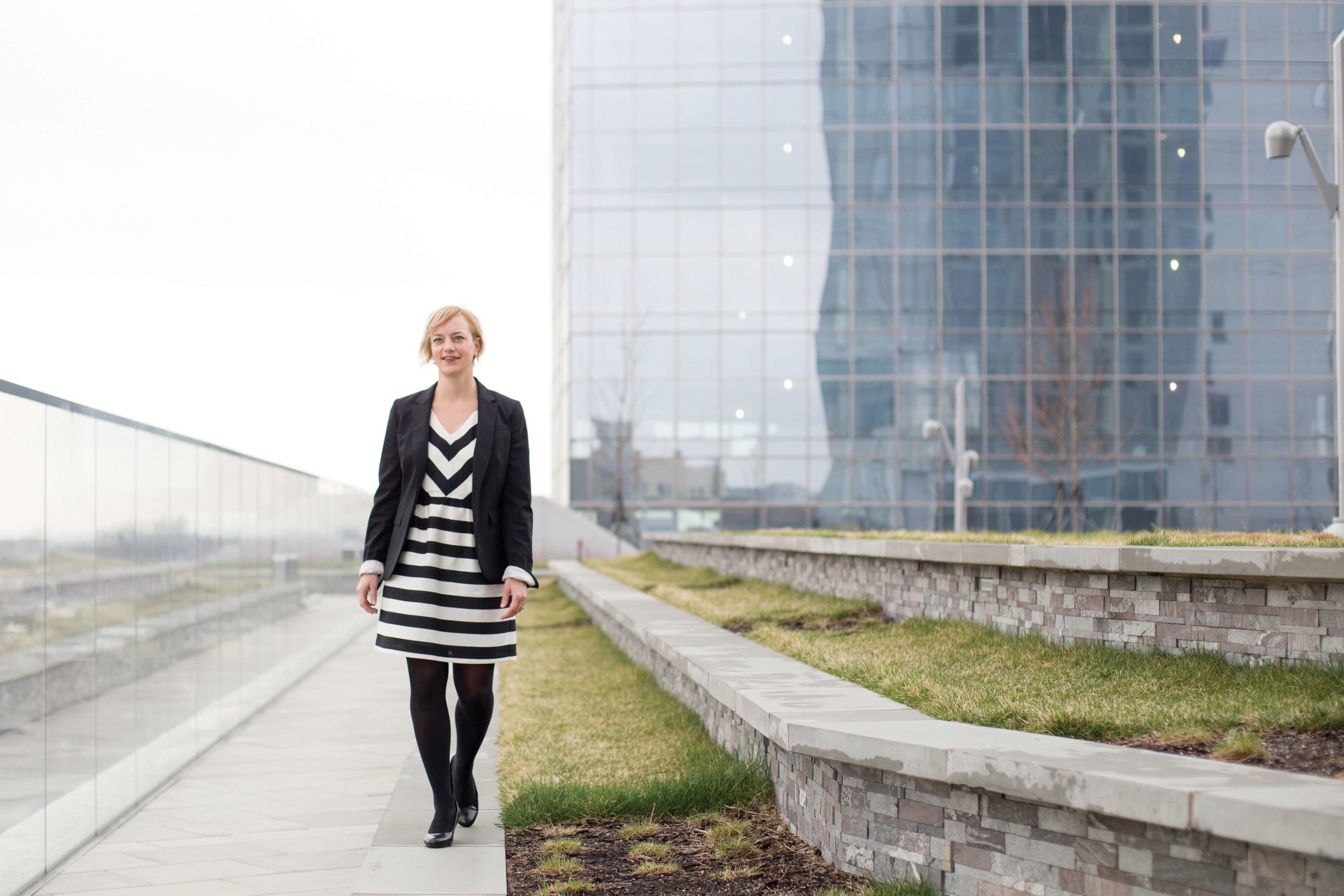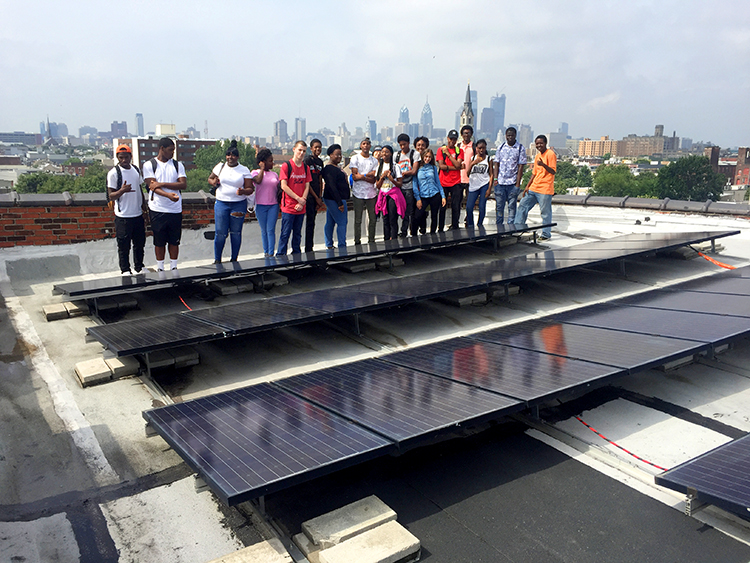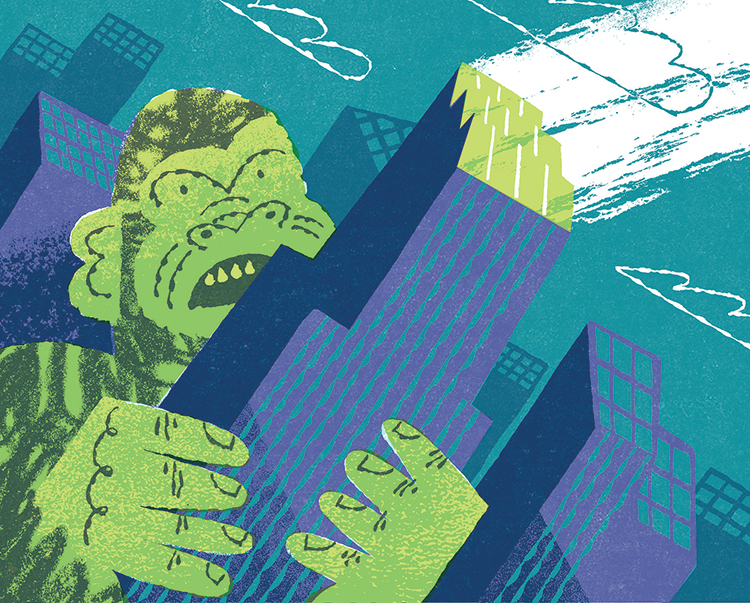Photo by Margo Reed
Moving Forward
by Heather Shayne Blakeslee
The new approach to Greenworks will be disorienting and disappointing for anyone who was looking for a big reveal on Mayor Kenney’s sustainability priorities. The new version, released in its printed form November 2016 by the Office of Sustainability (OOS), is emblematic of some big shifts in approach.
Gone are the 14 targets with baselines, metrics and goals; in their place are eight aspirational visions, such as “All Philadelphians waste less and keep our neighborhoods clean” and “All Philadelphians are prepared for climate change and reduce carbon pollution.”
But there is still a lot packed into the report. Given the sheer amount of work going on, as well as the number of departments involved, it was a struggle to list initiatives in order of importance, says Christine Knapp, who will lead OOS during the Kenney administration.
“There’s no weighting system we could come up with that we thought was fair,” Knapp says.
The result is a sometimes confusing mashup of task forces, advisory councils, plans and goals listed alphabetically by department underneath each vision. Knapp said she understands that the new format could be frustrating for the policy-and-metrics set, and that OOS is going to continue to work on how to best communicate with multiple audiences now that the printed version of Greenworks has evolved from a policy document to a communications piece directed at the general public. Knapp’s message to people uncomfortable with that shift? Be patient.
Dialing in to new numbers
In the same 2014 election that propelled Mayor Jim Kenney into office, Philadelphia voters passed 2-1 a ballot measure that made OOS permanent, essentially protecting its existence from the political whims of different mayoral administrations. However, like all city offices, the mayor still has wide latitude when it comes to how it’s staffed, whether budget resources are allocated and how aggressively a sustainability agenda will be pursued. Furthermore, the city’s original Greenworks plan, created under Mayor Michael Nutter, was set to expire at the end of his administration.
So there was widespread approval in the sustainability community when Kenney appointed Knapp, a long-time environmental advocate. (Full disclosure: Knapp is also a personal friend of mine.) There was a further collective sigh of relief when the office was funded at Nutter administration levels.
But the question remained: What would Kenney’s plan be moving forward? How committed is he compared with the Nutter administration?
The original Greenworks plan was created whole cloth under the leadership of inaugural director Mark Alan Hughes and then largely implemented by his successor, Katherine Gajewski; it was a metric-laden piece intended to set and accomplish goals within the time frame of the Nutter administration.
Knapp told an audience at Drexel University in November that some of the numbers in the first plan were too easily achievable, while others were a stretch, and that developing new metrics will be key, even if some of them take decades to accomplish.
She told Grid that OOS hopes to focus on “quality not quantity when it comes to the numbers.”
Part of that approach speaks to another big change in the plan, which is that equity indicators are baked into each of the eight visions instead of existing as a stand alone goal as it did the in the first version of Greenworks, alongside energy, environment, economy and engagement; a Greenworks Equity Index will guide their work. As an example, Knapp points to tree coverage goals and investments in parks.
“We do want to work with Parks and Recreation on figuring out what the appropriate goal is for new tree planting, but to be smarter about it and not just have a blanket number. If we only planted 50,000 trees, but they were in the neighborhoods that needed them the most, wouldn’t that be more effective for our overall strategy than just saying we were able to plant a lot and then have a bunch of them turn around and die? We’re really trying to be a little bit smarter about the approach that we’re taking, and not just trying to meet numbers for numbers’ sake.”
Another major part of the new strategy is moving the numbers online and keeping them updated regularly.
“We have a new Greenworks dashboard on our website that we only have part of up right now. We’re going to be adding to it over time so that we can update data more frequently… certain information we get regularly, [and now] we don’t have to wait for the annual report to put that information out,” Knapp says.
She also explains that a big structural change in how OOS relates to the rest of the city will help as they work closely with each department to develop goals and benchmarks.
“We’re now part of the Managing Director’s Office, rather than in the Mayor’s Office,” Knapp says. “This has been a really helpful position for us because we’re now among all of the other operating departments and have a common boss and common goals that we work on together. That’s really helped to break down some barriers and give us more access to those departments and to help them figure out what’s in the way—Is it budgetary? Is it information?—and help them overcome those barriers toward implementing the work.”
New audiences
Knapp says the change to moving metrics online and simplifying the printed report was based on community input.
“We heard from a lot of folks when we did our public feedback sessions that the previous Greenworks report was very complicated to the average person,” says Knapp, who is a veteran of soliciting and responding to community input; she led the Next Great City program at PennFuture and coordinated efforts at the Consortium for Building Energy Innovation at the Navy Yard. She also took a turn at the Philadelphia Water Department, where she was deputy chief of staff for the director of government affairs.
If you’re a community member, this report will give you a much better idea of which city departments are doing work toward these visions and what you can do to help.
“This is our first concerted effort to really have an external-facing engagement,” she says. “We’ve never had that in this office before, in part because the priority of the work was really getting it infused into city government and institutionalizing it here.”
As part of that outward-facing shift, Greenworks offers what may seem like remedial tidbits to hardcore advocates (like kicking your bottled water habit), but Knapp wants to get to the large portion of the city’s population who haven’t yet been engaged, rather than continuing to preach to the choir. The real meat of how to change your own behavior or become a better advocate is now online. A new program, Greenworks on the Ground, offers downloadable ideas and resources for each of the eight vision areas, organized by whether you are an individual, community group or institution, along with supportive resources.
Finally, Knapp also wants to be reassuring when it comes to the recent election results, which she says won’t affect the city’s plans.
“We can really do this work ourselves,” she says. “It does not rely on having that higher-level support. It would be great if we had higher-level policies that would help to drive change. What’s in our control is what’s in our plan, and what we ca
n do ourselves, we are going to continue to do.”
The upshot
There is a lot going on, and the focus on equity across visions is heartening. Advocates will have to wait for further serious plans and more metrics. Some reports are out, such as the climate-resilience-focused Growing Stronger plan and the water department’s internationally lauded Green City, Clean Waters effort. But other big-impact initiatives are forthcoming, such as the Energy Master Plan and the Transportation Master Plan. Following are Knapp’s picks for pieces of Greenworks that will have a big impact on our future as a sustainable city.
Greenworks 2016 Highlights
Food & Water
Vision
“All Philadelphians have access to healthy, affordable, and sustainable food and drinking water.”
First metric
The Greenworks report highlights the massive problem of food insecurity in Philadelphia, and its first metric is to track the number of Supplemental Nutrition Assistance Program (food stamp) participants who buy food at farmers markets.
In the works
A Shared Food Metric developed with the Philadelphia Food Policy Advisory Council and others that will better track whether more Philadelphians are getting access to healthful food. The city itself is also a big purchaser of goods, and plans are in the works to increase procurement of “healthy, fair, sustainably sourced food from locally owned businesses.”
Waste
Vision
“All Philadelphians waste less and keep our neighborhoods clean.”
First metric
Although population has increased, as has construction—notorious for creating the bulk of waste in landfills—our overall waste production is down, and the city wants to track that trend.
In the works
The approach here seems to be to take seriously the concept that “reduce” comes before “recycle,” and that litter is a perennial problem in the city that ranks high on neighborhood-level quality-of-life surveys. The city will create a Solid Waste Plan and a Zero Waste Plan and Task Force.
Transportation
Vision
“All Philadelphians have access to safe, affordable, and low carbon transportation.”
First metric
A majority of Philadelphians drive themselves to work, but an increasing number are walking, biking and using public transit, and the city wants to see that number continue to trend upward.
In the works
A cross-departmental Transportation Master Plan that takes into account effects of climate change, community health and racial equity in access to transportation is the keystone of this piece of Greenworks. Also listed in the report are an expansion of the Indego bike share program, investments in the trail system and an update to SEPTA’s sustainability plan.
Air Quality
Vision
“All Philadelphians breathe healthy air inside and outside.”
First metric
Outperforming the Environmental Protection Agency’s Air Quality Index standard for cities.
In the works
The air inside our homes can be terrible: Before we add mold, cigarette fumes and toxic releases from everything from new furniture to cleaning products, the air we take in from outside is already compromised. We’ll be finding out just how bad it is with an official street-level Air Monitoring Survey and developing ways to cut down on emissions from city vehicles through an alternative fuel vehicle study.
Energy
Vision
“All Philadelphians efficiently use clean energy that they can afford.”
First metric
The city is tracking energy use in relation to weather to ensure that there is actually a downward trend even during warm winters.
In the works
Efficiency standards will be built into one of Mayor Kenney’s signature programs, Rebuild, which will invest heavily across all neighborhoods in rebuilding parks, rec centers and libraries. Also in the works is an Energy Master Plan, which will analyze the myriad social, economic and environmental benefits of citywide energy policies, a project that dovetails with the Philadelphia Energy Authority’s Philadelphia Energy Campaign, which expects to spur $1 billion in investments over 10 years in energy efficiency projects and solar installation.
Climate Change
Vision
“All Philadelphians are prepared for climate change and reduce carbon pollution.”
First metric
The trend is downward when it comes to the city’s greenhouse gas emissions, and Mayor Kenney has set a goal of reducing carbon pollution 80 percent by 2050.
In the works
We’ll be moving into the implementation phase of the report, Growing Stronger: Toward a Climate Ready Philadelphia, which outlines the risks of climate change as they relate to major city departments such as Public Property, Public Health and the Office of Emergency Management.
Natural Resources
Vision
“All Philadelphians benefit from parks, trees, stormwater management and healthy waterways.”
First metric
Continuing to track tree cover, important for stormwater management and reducing how hot our neighborhoods are, will be the first metric here; where those trees are planted will become an even more important part of how the city uses this metric as it develops its Greenworks Equity Index, also a key part of the plan across its visions.
In the works
Continued implementation of the city’s lauded green infrastructure and stormwater management plan, Green City, Clean Waters, and development of a Clean Water Act Task Force, which will help move the plan along by studying opportunities and barriers to its implementation.
Education & Jobs
Vision
“All Philadelphians benefit from sustainability education, employment and business opportunities.”
First metric
The number of Philadelphians engaged in sustainability-related programs, including PowerCorps PHL, Waste Watchers, TreePhilly, Greenworks updates and the Philly Spring Cleanup.
In the works
A Workforce Development Pipeline project that will study how to create pathways to employment in clean economy jobs, and implementation of the GreenFutures report, the school district’s first sustainability plan.












